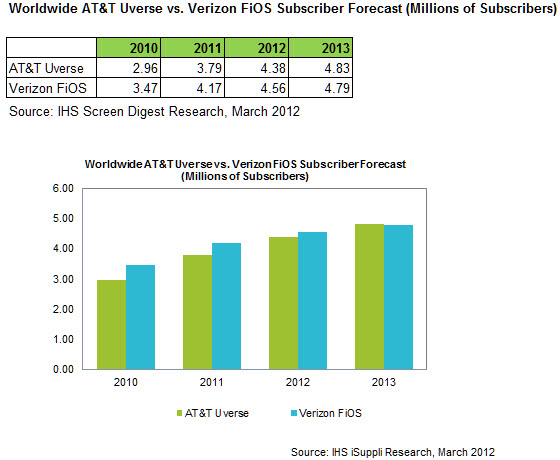
AT&T U-verse is closing in on Verizon FiOS in the Battle of the Telco TV Titans. According to IHS iSuppli Research, "AT&T in the fourth quarter of 2011 added more video subscribers to its U-verse service than cellular/wireless arch-rival Verizon did for its FiOS offering, marking the 10th straight quarter that AT&T has exceeded Verizon, according to the IHS Screen Digest U.S. Media Intelligence Service."
According to the report, AT&T added 208,000 U-verse accounts during the final quarter of 2011, for a total of 804,000 new subscribers for the year. Verizon on the other hand added 194,000 new subscribers in the fourth quarter, with a total of 701,000 additional subscribers in 2011. This is a 14,000 subscribe advantage last quarter to AT&T, which is why although they started later than Verizon they are closing the gap. Year-over-year growth for U-verse in 2011 compared with 2010 was up 27 percent, compared with FiOS which was up 20 percent in the same period.
Uverse subscribers at the end of 2011 totalled 3.79 million, with the lead by FiOS narrowed to just 400,000 TV subscribers. According to their chart numbers, AT&T should surpass Verizon in 2013. Indeed - "U-verse’s strong growth relative to FiOS is setting the stage for AT&T to take over the lead from Verizon by a nose at the end of 2013,” said Tom Adams, senior principal analyst for U.S. media at IHS.
Verizon uses fiber-to-the-home (FTTH), while AT&T uses a combination of fiber-to-the-nieghborhood and existing phone copper wiring (DSL technology) to the home. Verizon has the advantage of better speed and reliability, but their costs of deployment are much higher. Although interestingly, average revenue per unit (ARPU) in the fourth quarter for AT&T U-verse video customers amounted to $84.11, compared to $84.33 per month for Verizon subscribers. You would think AT&T's ARPU would be higher due to lower deployment costs, but perhaps Verizon FiOS customers are willing to pay a premium on faster Internet speeds and no HD issues that 'sometimes' plague Uverse deployments.
AT&T has nearly twice the household reach of Verizon - 30 million compared to 16.5 million, so they definitely have areas to deploy and get more customer sign-ups. The research report points out that an important milestone may be reached by Verizon in the first quarter of this year if it leaps over Charter Communications to become the sixth-largest multichannel operator in the United States. As former (unhappy: expensive, slow Internet, DVR sucked, channel surfing slow) Charter Communications cable customer, I can't wait to see the day Charter gets surpassed by the phone company. Maybe they'll actually put out a better service, at a better price, and with a better DVR/cable box. Though I'm not holding my breath... If AT&T and Verizon don't clobber Charter, Netflix's potential deal with some cablecos certainly will force Charter to improve their technology infrastructure and compete.












